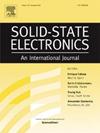柔性和轻便的III-V型聚光光伏汽车应用
IF 1.4
4区 物理与天体物理
Q3 ENGINEERING, ELECTRICAL & ELECTRONIC
引用次数: 0
摘要
利用太阳能发电在减少温室气体(GHG)造成的碳足迹方面具有巨大的潜力。虽然光伏(PV)已经在主流地面应用中被采用,但它们在汽车领域的实施,以制造光伏动力车辆,一直很少。现有的太阳能汽车使用低效率的太阳能电池,这限制了行驶里程20英里/天。在这项工作中,我们提出了用于汽车的聚光光伏(CPV)装置,该装置采用高效率的III-V太阳能电池,以实现更长的行驶里程。我们已经在金属带上开发了廉价且灵活的III-V光伏,并将它们与耐用,灵活的PDMS微透镜集成在一起,用于光集中。与没有光集中器的太阳能装置相比,集成装置在1个太阳下的电流密度和功率输出提高了9倍以上。使用与III-V型光伏集成的微透镜阵列可以将行驶里程延长到115英里/天,而电动里程为10英里/千瓦时。我们还研究了入射角对器件性能的影响,以评估将光伏组件安装在车顶时的最佳倾斜角度。本文章由计算机程序翻译,如有差异,请以英文原文为准。
Flexible & light-weight III-V concentrated photovoltaics for automobile application
Use of solar energy for electric power has a huge potential to reduce the carbon footprint caused by greenhouse gases (GHG). While photovoltaics (PV) has been adopted in mainstream terrestrial applications, their implementation in the automotive sector, to make PV-powered vehicles, has been minimal. The existing PV-powered vehicles utilize low-efficiency solar cells, which limits the driving range to 20 miles/day. In this work, we present concentrated photovoltaic (CPV) devices using high-efficiency III-V solar cells for automobile application to realize longer driving range. We have developed inexpensive and flexible III-V PV on metal tapes and integrated them with a durable, flexible PDMS microlens for light concentration. The integrated device showed more than 9 times improvement in current density and power output compared to a solar device without a light concentrator at 1 sun. Use an array of microlens integrated with III-V PV could extend the driving range to 115 miles/day for a vehicle with an electric mileage of 10 miles/kWh. We have also investigated the effect of the light incident angle on device performance to evaluate the optimal tilt angle while mounting the PV module on the vehicle’s roof.
求助全文
通过发布文献求助,成功后即可免费获取论文全文。
去求助
来源期刊

Solid-state Electronics
物理-工程:电子与电气
CiteScore
3.00
自引率
5.90%
发文量
212
审稿时长
3 months
期刊介绍:
It is the aim of this journal to bring together in one publication outstanding papers reporting new and original work in the following areas: (1) applications of solid-state physics and technology to electronics and optoelectronics, including theory and device design; (2) optical, electrical, morphological characterization techniques and parameter extraction of devices; (3) fabrication of semiconductor devices, and also device-related materials growth, measurement and evaluation; (4) the physics and modeling of submicron and nanoscale microelectronic and optoelectronic devices, including processing, measurement, and performance evaluation; (5) applications of numerical methods to the modeling and simulation of solid-state devices and processes; and (6) nanoscale electronic and optoelectronic devices, photovoltaics, sensors, and MEMS based on semiconductor and alternative electronic materials; (7) synthesis and electrooptical properties of materials for novel devices.
 求助内容:
求助内容: 应助结果提醒方式:
应助结果提醒方式:


